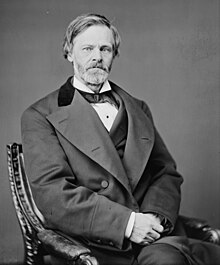John Sherman
| John Sherman | |
|---|---|
 |
|
| 35th United States Secretary of State | |
|
In office March 6, 1897 – April 27, 1898 |
|
| President | William McKinley |
| Preceded by | Richard Olney |
| Succeeded by | William R. Day |
| President pro tempore of the U.S. Senate | |
|
In office December 7, 1885 – February 26, 1887 |
|
| Preceded by | George F. Edmunds |
| Succeeded by | John James Ingalls |
|
United States Senator from Ohio |
|
|
In office March 21, 1861 – March 8, 1877 |
|
| Preceded by | Salmon P. Chase |
| Succeeded by | Stanley Matthews |
|
In office March 4, 1881 – March 4, 1897 |
|
| Preceded by | Allen G. Thurman |
| Succeeded by | Mark Hanna |
| 32nd United States Secretary of the Treasury | |
|
In office March 10, 1877 – March 3, 1881 |
|
| President | Rutherford B. Hayes |
| Preceded by | Lot M. Morrill |
| Succeeded by | William Windom |
| Member of the U.S. House of Representatives from Ohio's 13th district | |
|
In office March 4, 1855 – March 21, 1861 |
|
| Preceded by | William D. Lindsley |
| Succeeded by | Samuel T. Worcester |
| Personal details | |
| Born |
May 10, 1823 Lancaster, Ohio, U.S. |
| Died | October 22, 1900 (aged 77) Washington, D.C., U.S. |
| Political party | Whig, Oppositionist, Republican |
| Spouse(s) | Margaret Sarah Cecilia Stewart |
| Profession | Lawyer, Politician |
| Religion | Methodist |
| Signature | |
John Sherman (May 10, 1823 – October 22, 1900) was an American Republican representative and senator from Ohio during the Civil War and into the late nineteenth century. He also served as both Secretary of the Treasury and Secretary of State. Sherman ran for the Republican presidential nomination three times, coming closest in 1888, but never won. His brothers included General William Tecumseh Sherman, Charles Taylor Sherman, a federal judge in Ohio, and Hoyt Sherman, an Iowa banker.
Born in Lancaster, Ohio, Sherman later moved to Mansfield, Ohio, where he began a law career before entering politics. Initially a Whig, Sherman was among those anti-slavery activists who formed what became the Republican Party. He served three terms in the House of Representatives. As a member of the House, Sherman traveled to Kansas to investigate the unrest between pro- and anti-slavery partisans there. He rose in party leadership and was nearly elected Speaker in 1859. Sherman was elevated to the Senate in 1861. As a senator, he was a leader in financial matters, helping to redesign the United States' monetary system to meet the needs of a nation torn apart by civil war. After the war, he worked to produce legislation that would restore the nation's credit abroad and produce a stable, gold-backed currency at home.
Serving as Secretary of the Treasury in the administration of Rutherford B. Hayes, Sherman continued his efforts for financial stability and solvency, overseeing an end to wartime inflationary measures and a return to gold-backed money. He returned to the Senate after his term expired, serving there for a further sixteen years. During that time he continued his work on financial legislation, as well as writing and debating laws on immigration, business competition law, and the regulation of interstate commerce. Sherman was the principal author of the Sherman Antitrust Act of 1890, which was signed into law by President Benjamin Harrison. In 1897, President William McKinley appointed him Secretary of State. Failing health and declining faculties made him unable to handle the burdens of the job, and he retired in 1898 at the start of the Spanish–American War. Sherman died at his home in Washington, D.C. in 1900.
...
Wikipedia
